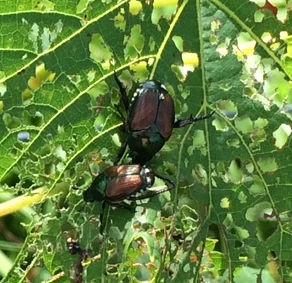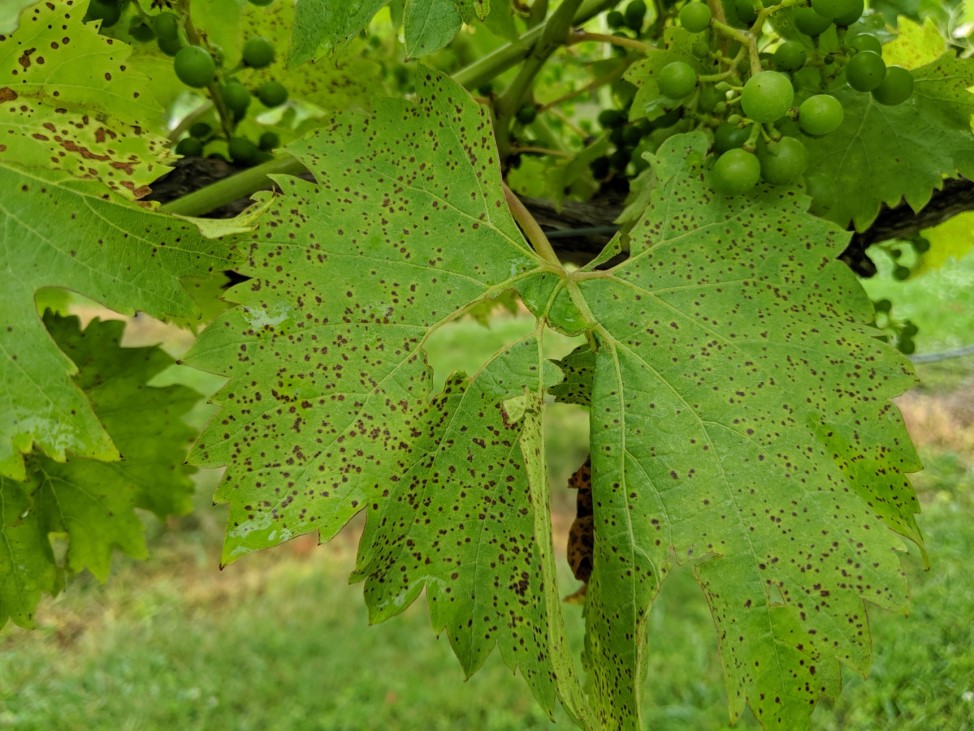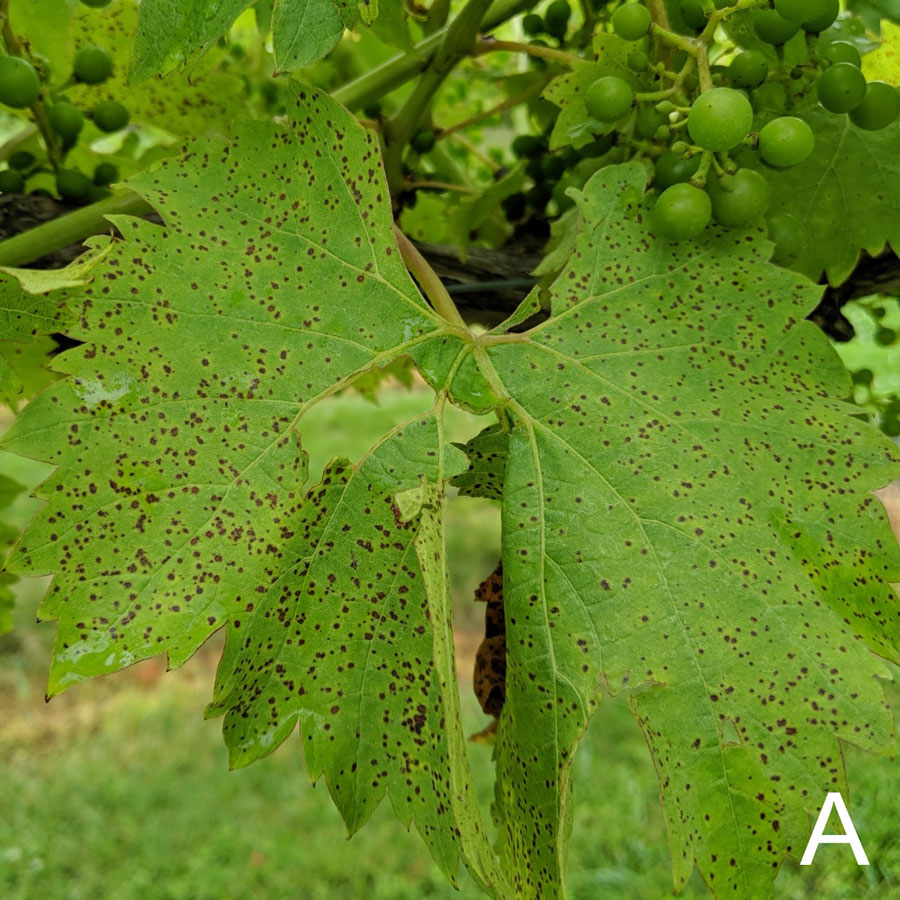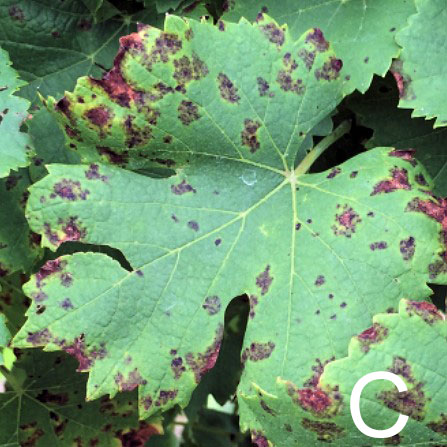Vinews
No. 13 — June 17, 2019
Contents:
- Japanese Beetles Have Emerged
- Rupestris Speckle
- Cumulative Growing Degree Days for the Seven Grape Growing Regions of Missouri from April 1 to June 17, 2019
Japanese Beetles Have Emerged

Be aware that Japanese beetles have emerged and have been reported in the following regions: East Central, Northeast and West Central Missouri. For more specific information on trap captures and trap locations visit the MU Integrated Pest Management website.
Adult Japanese beetle populations are likely to continue to rise until mid-July or later. Adult Japanese beetle emergence will be helped along by consistent thunderstorms that have provided abundant rainfall. Moist soil conditions increases the emergence of adult Japanese beetles compared to dry soil conditions.
Since rainfall is currently a consistent threat weekly be aware that some of the insecticides applied to control Japanese beetles will have reduced effectiveness after rainfall events.
Rainfall events that produce large amounts of rain can decrease insecticide residues. A simulated 1-inch rainfall removed 63% of the carbaryl (Sevin) applied as a wettable powder to cotton plants 2 h after application (Willis et al. 1988). A similar study conducted on soybeans produced similar results. A 1-inch rainfall removed 67% of carbaryl applied as Sevin XLS Plus. The authors conclude that rainfall amount has greater impact on wash off of carbaryl than the intensity of rainfall (Willis et al 1996).
Pesticides can degrade in the environment as a result of temperature, UV light, plant metabolism, and microorganisms. Rainfall also plays an important role in removing pesticides from plants. Carbaryl applied to grapevines is pretty rain-fast and provides good protection when rainfall is 0.5 inch or less (Hulbert et al. 2011). If rainfall is 1 inch or greater, there is insufficient carbaryl residues to protect leaf tissue. Besides loosing carbaryl to rainfall, temperature can also play role in carbaryl stability. Carbaryl becomes unstable at higher temperatures and has a short half life during the warmest months. Typically July and August are the hottest months in Missouri.
Refer to Grape insecticide precipitation wash-off reapplication decision chart — Japanese beetles. This chart was developed by Michigan State University from research that evaluated five different insecticides from five insecticide classes (Organophosphate, Carbamate, Pyrethroid, Neonicotinoid, and Oxadazine).
Take Home
- Sevin will protect your vines from Japanese beetles if 0.5 inches of rain or less has fallen. If 1 inch of rain or more has fallen, there are insufficient Sevin residues to protect against Japanese beetles. If large rainfall events are forecast consider using other insecticides that provide sufficient residues for protection or reapply Sevin.
- Lastly, always direct applications of Sevin into the top of the grapevine canopy where Japanese beetles are mainly feeding. Directing your spray application to the upper canopy limits Sevin residues on your berries.
References
- Hulbert, D., R. Isaacs, C. Vandervoort, and J. C. Wise. 2011. Rainfastness and residual activity of insecticides to control Japanese beetle (Coleoptera: Scara-baeidae) in grapes. J Econ. Entomol. 104:1656-1664.
- Willis, G.H., S. Smith, L.L. McDowell, and L.M. Southwick. 1996. Carbaryl washoff from soybean plants. Archives of Environmental Contamination and Toxicology. 31:239-243.
- Willis, G.H., L.L. McDowell, s. Smith, and L.M. Southwick. 1988. Rainfall amount and intensity effects on carbaryl washoff from cotton plants. Transactions of ASAE. 31:86-90.
Rupestris Speckle

Rupestris speckle is a physiological disorder that affects certain grape cultivars. Grape cultivars that are affected have Vitis rupestris in their heritage. Many of the hybrid grape cultivars have some Vitis rupestris in their genetic background. Grape cultivars affected by the disorder show different degrees of speckling (Figure 1). Valvin muscat typically displays moderate to severe speckling. Whereas, Chambourcin displays minor to moderate speckling. The physiological cause of the disorder is not known, but the disorder has been linked to stress that causes reduced or low vigor. The degree of the stress likely plays a role since Rupestris speckle does not appear every year and the degree of speckling often is different from year to year. The last time the disorder was reported by multiple growers in Missouri was in 2016.
What makes Rupestris speckling confusing is the degree of speckling that often resembles many fungal diseases. The speckles resemble black rot (Guignardia bidwellii) lesions. You can distinguish black rot from Rupestris speckles by looking at the lesions with a 10X handlens. Black rot lesions will contain black dots or fruiting bodies (pycnidia) whereas Rupestris speckles will be void of lesions. Other disease symptoms that resemble Rupestris speckles are Septoria leaf spot, Septoria ampelina and bacterial leaf spot, Xanthomonas campestris pv. viticola. Septoria leaf spot can be distinguished from Rupestris speckles once again by using a 10x hand lense to observe if fruiting bodies are apparent within the lesion. In addition, Septoria leaf spot mainly affects American Vitis species as well muscadine grapes. Bacterial leaf spot affects young growing shoots, leaves and berries. Whereas, Rupestris speckles mainly affects older leaves.
Since Rupestris speckle is a physiological disorder there are no control recommendations.



Cumulative Growing Degree Days for the Seven Grape Growing Regions of Missouri from April 1 to June 17, 2019
| Region | Location by County | Growing Degree Days1 | ||
|---|---|---|---|---|
| 2019 | 2018 | 30-year Average | ||
| Augusta | St. Charles | 1115 | 1274 | 1123 |
| Hermann | Gasconade | 1066 | 1194 | 1057 |
| Ozark Highland | Phelps | 1154 | 1320 | 1149 |
| Ozark Mountain | Lawrence | 1142 | 1320 | 1132 |
| Southeast | Ste. Genevieve | 1129 | 1297 | 1138 |
| Central |
Boone | 1098 | 1298 | 1074 |
| Western | Ray | 995 | 1217 | 1030 |
1 Growing degree days at base 50 from April 1 to June 17, 2019. Data compiled from Useful and Useable at https://mygeohub.org/groups/u2u/tools. Click on link below to determine growing degree days in your area.
To determine the number of growing degree days accumulated in your area since April 1, use this tool.